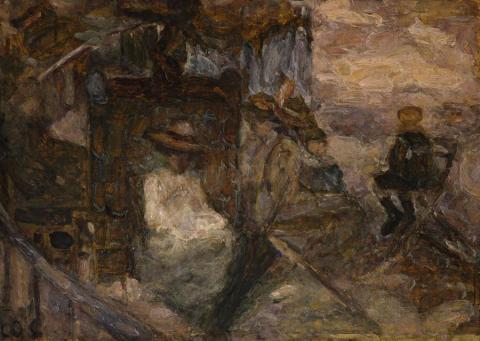LUXEMBOURG GARDENS, PARIS, GIRL SKETCHING, c.1917-23
KATE O'CONNOR
oil on board
42.5 x 59.5 cm
signed with initials lower left: KOC
signed (twice) verso: Oconnor
signed and inscribed on artist's label verso: Luxemberg [sic] Gardens / Paris / Girl sketching / KLOConnor
Mervyn Horton, Sydney (label attached verso)
Private collection, Perth
Sotheby's, Sydney, 15 August 2000, lot 68
Private collection, Perth
Harris, M., 'Kate O'Connor', Art and Australia, vol. 3, no. 4, March 1966, p. 271 (illus.)
Woman in a Hat Sketching - Luxembourg Gardens, illus. in Harris, M., 'Kate O'Connor', Art and Australia, vol. 3, no. 4, March 1966, p. 267
Kate O'Connor's paintings captivate through their superb handling of colour and informal mastery, a moment captured as a work of art. The Luxembourg Gardens in Paris inspired many, all handled with an ease that is redolent of their time and place - of ladies relaxing, nurses of Brittany with children in their care, and the delightful Woman in a Hat Sketching - Luxembourg Gardens, once in the collection of the artist Robert Campbell, one time director of the Art Gallery of South Australia.1 The affinity between this work and our Luxembourg Gardens, Paris, Girl Sketching goes beyond the thematic in harmony of painterly pleasure and engaging mood. Yet, imbued as they are with relaxation, each is enlivened by the strokes of the brush, full of movement and interchange - silently talkative. They are not conversation pieces in the traditional sense, rather conversations shared with the viewer through their liveliness and spontaneity, frequent back views balancing intimacy with anonymity. The outstanding quality of our painting is acknowledged by its provenance, once being in the collection of the leading Sydney connoisseur, Mervyn Horton, founder-editor of Art and Australia, refined of taste and perception.
Many an Australian artist was attracted to the Luxembourg Gardens during the first two decades of the twentieth century - Bessie Davidson, Hilda Rix Nicholas, Marie Tuck, and of course Emanuel Phillips Fox, his English wife Ethel Carrick Fox, and Rupert Bunny. Bunny possibly introduced O'Connor to the gardens, for it was here that he found inspiration to do a series of paintings of the spring of 1909, the same year O'Connor was briefly his pupil. O'Connor's early Luxembourg Gardens paintings date from 1910-14.2 Two, Esquisse (Jardin du Luxembourg) and Equisse were exhibited in the 1913 Salon d'Automne, achieving the distinction of being favourably reviewed.3 Like Carrick towards the end of the Great War, O'Connor returned to the gardens in 1917, when her beautifully muted palette showed the further enriching influence of Edouard Vuillard, who O'Connor had met at that time. Writing years later, Max Harris referred to 'the singing chromatic scales she finds on her palette'.4 These hues, that lead to dissolution of form and flat patterning, conversely develop form through colour. One welcomes the new interest in paint surfaces, figures subtle in definition disappearing and appearing, inviting enjoyment of the painting's figurative and abstract qualities as one. The twenties were one of O'Connor's most creative periods, exhibiting Luxembourg Gardens scenes, portraits, and still lifes at the Paris Sociétédes Artistes Indepéndants and the Salon d'Automne. Although O'Connor established a French reputation, her achievements were never fully realized in Australia. Her free-spirited style, derived from Irish-Celtic complexity and Australian directness, with an overlay of European sensibility, deserves more.
1. See Harris, M., 'Kate O'Connor', Art and Australia, vol. 3, no. 4, March 1966, p. 267 (illus.)
2. For examples, see Gooding, J., Chasing Shadows: The Art of Kathleen O'Connor, Craftsman House, Sydney, 1996, pl. 60-65
3. Habert, M., Beaux Arts, Paris, 'De Mlle O'Connor, Le Blanc et les Dos, Les Dos et les Chaises, pochades bien assises ...' (Miss O'Connor, The Bench and the Backs, The Backs and the Chairs, well set out pochades ...). Quoted in Hutchings, P. AE., and Lewis, J., Kathleen O'Connor: Artist in Exile, Fremantle Arts Centre Press, Perth, 1987, pp. 169-170
4. Harris, op. cit., p. 268
DAVID THOMAS
